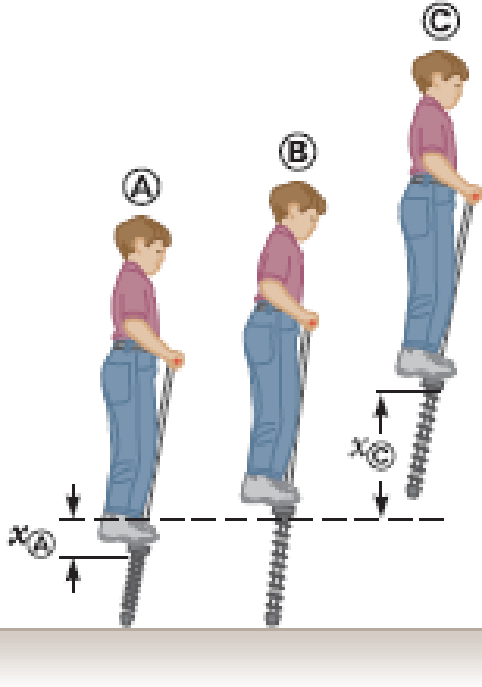
Concept explainers
A child’s pogo stick (Fig. P7.69) stores energy in a spring with a force constant of 2.50 × 104 N/m. At position Ⓐ (xⒶ = −0.100 m), the spring compression is a maximum and the child is momentarily at rest. At position Ⓑ (xⒷ = 0), the spring is relaxed and the child is moving upward. At position Ⓒ, the child is again momentarily at rest at the top of the jump. The combined mass of child and pogo stick is 25.0 kg. Although the boy must lean forward to remain balanced, the angle is small, so let’s assume the pogo stick is vertical. Also assume the boy does not bend his legs during the motion. (a) Calculate the total energy of the child–stick–Earth system, taking both gravitational and elastic potential energies as zero for x = 0. (b) Determine xⒸ. (c) Calculate the speed of the child at x = 0. (d) Determine the value of x for which the kinetic energy of the system is a maximum. (e) Calculate the child’s maximum upward speed.
Figure P7.69

(a)
Total energy of the system.
Answer to Problem 69P
Total energy is
Explanation of Solution
Write the equation for total energy of the system
Here
Write the equation for kinetic energy at A, B and C
Here
Write the expression for gravitational potential energy at A, B and C.
Here
Write down the equation for elastic potential energy at A, B and C.
Here
As there is no motion, kinetic energy is zero
Substitute
Conclusion:
Substitute
Total energy is
(b)
Extension at point C.
Answer to Problem 69P
Extension is
Explanation of Solution
Write the energy conservation equation
Substitute for all the terms in (VI)
Kinetic energy is zero as there is no motion
The elastic potential energy is zero at C.
Now rewrite (VII) in terms of
Conclusion:
Substitute
Extension is
(c)
Speed of the child at
Answer to Problem 69P
The speed is
Explanation of Solution
Write the energy conservation equation.
At
Kinetic energy at A is also zero.
Then rewrite (IX) in terms of
Conclusion:
Substitute
The speed is
(d)
Value of
Answer to Problem 69P
Kinetic energy is maximum at
Explanation of Solution
Write the energy of the system when the spring is compressed
Rewrite (XI) in terms of
Rewrite (XII) in terms of
Conclusion:
Substitute
As this the value for compression, the position is below
Therefore,
Kinetic energy is maximum at
(e)
Maximum upward speed.
Answer to Problem 69P
Maximum speed is
Explanation of Solution
Write the equation for maximum kinetic energy
Substitute (III) and (IV) in (XIV)
Rewrite (XV) in terms of
Conclusion:
Substitute
Maximum speed is
Want to see more full solutions like this?
Chapter 7 Solutions
Principles of Physics
- A horizontal spring attached to a wall has a force constant of k = 850 N/m. A block of mass m = 1.00 kg is attached to the spring and rests on a frictionless, horizontal surface as in Figure P7.55. (a) The block is pulled to a position xi = 6.00 cm from equilibrium and released. Find the elastic potential energy stored in the spring when the block is 6.00 cm from equilibrium and when the block passes through equilibrium. (b) Find the speed of the block as it passes through the equilibrium point. (c) What is the speed of the block when it is at a position xi/2 = 3.00 cm? (d) Why isnt the answer to part (c) half the answer to part (b)? Figure P7.55arrow_forwardA particle moves in one dimension under the action of a conservative force. The potential energy of the system is given by the graph in Figure P8.55. Suppose the particle is given a total energy E, which is shown as a horizontal line on the graph. a. Sketch bar charts of the kinetic and potential energies at points x = 0, x = x1, and x = x2. b. At which location is the particle moving the fastest? c. What can be said about the speed of the particle at x = x3? FIGURE P8.55arrow_forwardA 4.00-kg particle moves along the x axis. Its position O varies with time according to x = t + 2.0t3, where x is in meters and t is in seconds. Find (a) the kinetic energy of the particle at any time t (b) the acceleration of the particle and the force acting on it at time t, (c) the power being delivered to the particle at time t and (d) the work done on the particle in the interval t = 0 to t = 2.00 s.arrow_forward
- The Flybar high-tech pogo stick is advertised as being capable of launching jumpers up to 6 ft. The ad says that the minimum weight of a jumper is 120 lb and the maximum weight is 250 lb. It also says that the pogo stick uses a patented system of elastometric rubber springs that provides up to 1200 lbs of thrust, something common helical spring sticks simply cannot achieve (rubber has 10 times the energy storing capability of steel). a. Use Figure P8.32 to estimate the maximum compression of the pogo sticks spring. Include the uncertainty in your estimate. b. What is the effective spring constant of the elastometric rubber springs? Comment on the claim that rubber has 10 times the energy-storing capability of steel. c. Check the ads claim that the maximum height a jumper can achieve is 6 ft.arrow_forwardA block of mass m = 2.50 kg is pushed a distance d = 2.20 m along a frictionless, horizontal table by a constant applied force of magnitude F = 16.0 N directed at an angle = 25.0 below the horizontal as shown in Figure P6.3. Determine the work done on the block by (a) the applied force, (b) the normal force exerted by the table, (c) the gravitational force, and (d) the net force on the block. Figure P6.3arrow_forwardA block of mass 0.250 kg is placed on top of a light, vertical spring of force constant 5 000 N/m and pushed downward so that the spring is compressed by 0.100 m. After the block is released from rest, it travels upward and then leaves the spring. To what maximum height above the point of release does it rise?arrow_forward
- A nonconstant force is exerted on a particle as it moves in the positive direction along the x axis. Figure P9.26 shows a graph of this force Fx versus the particles position x. Find the work done by this force on the particle as the particle moves as follows. a. From xi = 0 to xf = 10.0 m b. From xi = 10.0 to xf = 20.0 m c. From xi = 0 to xf = 20.0 m FIGURE P9.26 Problems 26 and 27.arrow_forwardA particle is subject to a force Fx that varies with position as shown in Figure P7.9. Find the work done by the force on the particle as it moves (a) from x = 0 to x = 5.00 m, (b) from x = 5.00 m to x = 10.0 m, and (c) from x = 10.0 m to x = 15.0 m. (d) What is the total work done by the force over the distance x = 0 to x = 15.0 m?arrow_forwardConsider the blockspringsurface system in part (B) of Example 8.6. (a) Using an energy approach, find the position x of the block at which its speed is a maximum. (b) In the What If? section of this example, we explored the effects of an increased friction force of 10.0 N. At what position of the block docs its maximum speed occur in this situation?arrow_forward
- A small 0.65-kg box is launched from rest by a horizontal spring as shown in Figure P9.50. The block slides on a track down a hill and comes to rest at a distance d from the base of the hill. The coefficient of kinetic friction between the box and the track is 0.35 along the entire track. The spring has a spring constant of 34.5 N/m, and is compressed 30.0 cm with the box attached. The block remains on the track at all times. a. What would you include in the system? Explain your choice. b. Calculate d. c. Compare your answer with your answer to Problem 50 if you did that problem.arrow_forwardA block of mass 200 g is attached at the end of a massless spring of spring constant 50 N/m. The other end of the spring is attached to the ceiling and the mass is released at a height considered to be where the gravitational potential energy is zero. (a) What is the net potential energy of the block at the instant the block is at the lowest point? (b) What is the net potential energy of the block at the midpoint of its descent? (c) What is the speed of the block at the midpoint of its descent?arrow_forwardA small object is attached to two springs of the same length l, but with different spring constants k1 and k2 as shown in Figure P9.31. Initially, both springs are relaxed. The object is then displaced straight along the x axis from xi to xf. Find an expression for the work done by the springs on the object.arrow_forward
 Principles of Physics: A Calculus-Based TextPhysicsISBN:9781133104261Author:Raymond A. Serway, John W. JewettPublisher:Cengage Learning
Principles of Physics: A Calculus-Based TextPhysicsISBN:9781133104261Author:Raymond A. Serway, John W. JewettPublisher:Cengage Learning Physics for Scientists and Engineers: Foundations...PhysicsISBN:9781133939146Author:Katz, Debora M.Publisher:Cengage Learning
Physics for Scientists and Engineers: Foundations...PhysicsISBN:9781133939146Author:Katz, Debora M.Publisher:Cengage Learning Physics for Scientists and Engineers with Modern ...PhysicsISBN:9781337553292Author:Raymond A. Serway, John W. JewettPublisher:Cengage Learning
Physics for Scientists and Engineers with Modern ...PhysicsISBN:9781337553292Author:Raymond A. Serway, John W. JewettPublisher:Cengage Learning Physics for Scientists and EngineersPhysicsISBN:9781337553278Author:Raymond A. Serway, John W. JewettPublisher:Cengage Learning
Physics for Scientists and EngineersPhysicsISBN:9781337553278Author:Raymond A. Serway, John W. JewettPublisher:Cengage Learning University Physics Volume 1PhysicsISBN:9781938168277Author:William Moebs, Samuel J. Ling, Jeff SannyPublisher:OpenStax - Rice University
University Physics Volume 1PhysicsISBN:9781938168277Author:William Moebs, Samuel J. Ling, Jeff SannyPublisher:OpenStax - Rice University Physics for Scientists and Engineers, Technology ...PhysicsISBN:9781305116399Author:Raymond A. Serway, John W. JewettPublisher:Cengage Learning
Physics for Scientists and Engineers, Technology ...PhysicsISBN:9781305116399Author:Raymond A. Serway, John W. JewettPublisher:Cengage Learning





